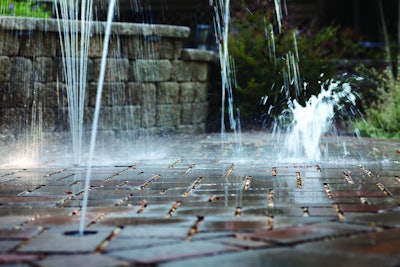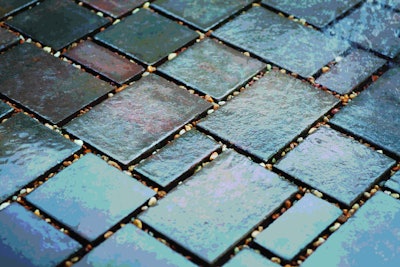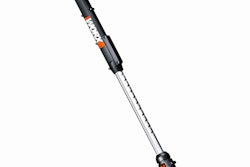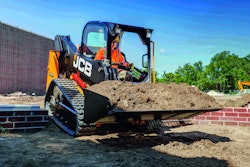 This outdoor living space located in Charlotte, North Carolina designed by Legacy Landscaping, includes a patio, firepit and splash pad.
This outdoor living space located in Charlotte, North Carolina designed by Legacy Landscaping, includes a patio, firepit and splash pad.Photo: Belgard
Permeable pavement and permeable pavers have been available for decades, but many contractors still have the impression that the permeable interlocking concrete pavers (PICP) are best used in commercial or municipal settings.
While it is true that permeable pavers are ideal for these applications, they also offer a wealth of benefits for homeowners and communities in residential environments. As homeowners become familiar with permeable pavers and demand begins to increase, contractors should be educated on the background, benefits and installation best practices for these eco-friendly pavers.
For those unfamiliar with permeable pavers, they are installed with layers of varying-sized stone or aggregate underneath that filter and allow rainwater to replenish underground aquifers.
Permeable paving essentially mimics the way natural land absorbs water – meaning that any rain that falls on the surface is filtered and seeps back into the ground, instead of flowing into the nearest storm drain or stream. In addition, with enhanced design techniques, collected water can be harvested for homeowner use such as watering plants or washing cars.
Permeable pavers offer a number of benefits for both homeowners and communities. For homeowners, permeable pavers:
- Reduce water demand by paving over natural areas
- Aid landscaping by reducing erosion that occurs when grass is dry and dead
- Eliminate standing water where mosquitoes can breed
- Last much longer than conventional paved surfaces
These environmental benefits also extend to communities:
- Filter water back underground to recharge local groundwater supplies
- Maintain base flows in rivers to keep ecosystems self-sustaining
- Minimize heat island effect when using highly reflective, light-colored pavers
- Reduce water use for landscaping
Water filtration is an additional benefit that many are not aware of. As rainwater hits a normal surface, such as concrete or asphalt, it picks up pollution elements such as oil or gas, which in turn enters the groundwater. With permeable pavement, bacteria grows within the aggregate below, which helps to break down those materials and harmful toxins, filtering them out before the water goes back into the ground.
While the benefits of permeable pavers are clear, contractors may be wary of the installation process. However, there are three key rules to follow to ensure accurate and functional installation of permeable pavers.
- Understand the goal – As with any project, contractors need to clearly understand what the homeowner’s goal is with the permeable pavers. Though permeable pavers have a wide use, some applications may not work. If the customer is hoping to collect water for their own use, different design techniques will need to be implemented from the start.
- Conduct test digs – Various soil types will affect the installation process, especially how much excavation is required for water storage under the pavers and ground. Test digs are recommended to determine soil type and guide design. For example, heavy clay soil will differ from sand due to varying filtration rates and contractors need to determine the depth of the base aggregate that is needed to contain the water based on the rain event, so that the storage basin doesn’t overflow.
- Use consistent and appropriate aggregate – It is imperative that the aggregate used beneath the pavers is both consistent and appropriate for the application. Contractors should keep in mind that whatever the pavers are laid upon will be reflected on the paver installed on top. In addition, different applications call for different types of aggregate. For example, in a high-trafficked area such as a pool deck, the installer may want to stay away from crushed or angular aggregate, as that might easily come out and stick to someone’s foot, and instead utilize one that is slightly more rounded. In such an application, sealers can also be applied which will solidify the aggregate, ensuring that it remains in the joints.
 Photo: Belgard
Photo: BelgardOverall, contractors should look for a permeable paver provider that serves as a true partner and provides the support and resources necessary to ensure the installation is done correctly. The supplier will know their product best and can provide guidance every step of the way, making business easier and keeping the customer happy.
Permeable paving within the residential market will continue to grow, as more consumers become aware of the benefits to their home, property and local environment. They provide a beautiful solution for hardscapes, as well as promote ongoing stewardship of our beautiful communities.
EDITOR’S NOTE: This article was written by Joe Raboine, national design and training specialist with Belgard Design Studios.









